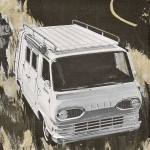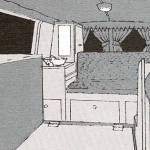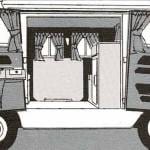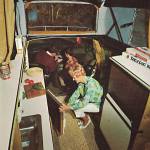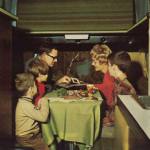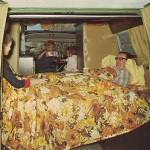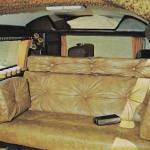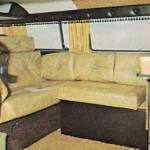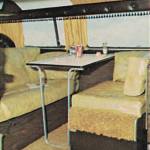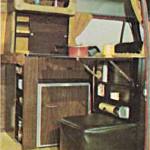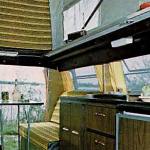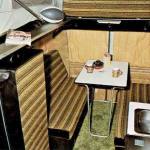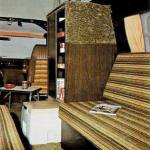Sportsmobile 1961
Sportsmobile, our original name was Sportswagons, was founded in El Paso, TX by Curtis and Charles Borskey. Curtis resigned in 1964. Charles is still working. In 1964 the company relocated to Indiana and changed the name to Sportsmobile. Sportsmobile Texas was started in Austin, TX in 1984. Sportsmobile West was licensed to build Sportsmobiles in 1990. Sportsmobile Texas is the principal office serving as the coordinating point for design, marketing, quality control standards, etc.

Our original plant in El Paso, Texas.

Manufacturing the camper conversion kits.

Packaging the kits. There were 5 crates per kit.

Ready for shipping by truck or rail to the installation locations.

Ready for sale. The top rack and awning were separate options.
The 60’s

1961 VW
Our first van conversions were state-of-the-art at the time, but very basic compared with today’s. Not much changed until the 70s.

1961 Ford and Chevy
The van’s engine was located between the cab seats. They were underpowered, noisy, and the ride was a little rough. A/C? Open the windows!
Life was simple back then.
To raise our first top you climbed up the rear ladder and crawled in through the rear while pushing the top up. To lower – reverse the procedure.
The interiors were functional and attractively furnished. As stated above they were quite basic. The icebox required a block of ice. The toilet was a bucket with a seat. Freshwater was in a 5-gallon jerry can. Etc.
There were no federal safety standards or RVIA codes for electrical, plumbing, and propane. Seat belts, airbags? Not till a couple of decades later.

Fast forward to today. Amazing improvements in the vans and conversions.
Sportsmobile • Dodge • Ford • Chevy
Camper unit transforms the Ford Econoline into a home-on-wheels that’s especially comfortable. Dining area converts to double be, and with 60-inch bed over the engine cover and sleeping accommodations for two adults and two children are provided. Optional cabana tent provides additional camping room. Interiors attractively finished in birch paneling, red or turquoise upholstering, plus matching curtain materials.
Standard Features
- 3-in. Polyfoam cushions, red or turquoise vinyl upholstered
- 15-gal. water tank – Gravity faucet
- Ample storage for housekeeping needs
- 50-lb. icebox
- Decorative wall lamp two dome light fixtures
- Table with Armstrong Carlon top
- Any other features? Nope.
- Life was simple back then.
Optional Features
- Luggage rack, sun deck, ladder
- Cabana tent (colorful candy-strip pattern)
- Padded seat rest, converts to extra bed
- Carlon chemical toilet
- Adjustable flame LP gas stove
- Sling Bed for cab
- Awning-type windows for rear doors.

The '68 Ford Super Econoline was quite an improvement over the early model. Our first full size top utilized the van's metal roof with fiberglass panels. To raise you pushed up the spring
loaded front and then the rear. It was a little cumbersome.

Good space organization is an enticing Sportsmobile feature. The open floor plan has logical, practical divisions of space for food preparation, dining, sleeping, and living. Generous counter space and storage areas.
Roomy, comfortable double bed with 4″ elbow space to rear. The bed is 4″ firm foam covered with Scotch-Guarded Nylon. Makes up easily by using one backrest cushion, with its folding legs, for the center section. Large louvered windows let soft evening breezes in for comfortable cross ventilation. The bed can be left made-up during travel. – 1973 text.
The 70’s
Sportsmobile VW

Our first pop-top that raised and lowered from inside the van. It provided more space, ventilation, and visibility. Plus you didn’t have to bend over to put your pants on.

The interiors were more comfortable with a lot more features and options in the 70s. An example, the ice-box was replaced with a refrigerator.
Early Years
Penthouse


Later we developed our "Penthouse" top. Others had elevating tops but ours was the first full roof size with a mattress bed in place of a hammock. Plus we engineered our dual u-tube, spring loaded, raise/lower from one position, patented elevating system making it easy to raise and lower the top manually. Later we added power – just push a button!
The Clubcar – A Limited Edition
Much More Than a Conventional Automobile!

The Clubcar was a special model built for VW distributors. It was designed more as an alternative for family use with some camping capability — in place of a car. The rear seat was exceptionally comfortable with a lounge position. That would convert into a bed. A large moonroof was in the ceiling.
The Surfer – A Limited Edition
Wow! This was quite a departure from our more conservative approach to styling. This wild thing was first popularized in California. We decided to develop our own version with lots of fake fur and shag carpet to see what the market might bring. To our surprise – we couldn’t build them fast enough. However, after a few years sales steadily declined. So we quit.
Sportsmobile • Dodge • Ford • Chevy


Town & Country Pleasure Wagons
Much More Than a Conventional Automobile
“More than 95% of owners enjoy Sportsmobile as the family’s first or second automobile. On weekends a Sportsmobile is a ball! For neighborhood socializing; overnight along the river or in the woods; from football to opera… name your
pleasure. Always ready to go on a moment’s notice.” – 1973 text.
This conversion plan was one of our most popular in the 70’s. Still is – updated. Favorite colors were avocado green and harvest gold. Short shag carpet and dark walnut cabinets were also first choices. Plaid upholstery later took over.
4×4 conversions were available for the Ford Econoline vans in the earlier 70’s (1971 Ford in photo). Sportsmobile first used the Pathfinder 4×4 conversions for years. They were tough and rode rough.To engage the 4×4 you had to get out and lock the hubs. Today’s 4×4 have an electrical system that selectively brakes individual wheels for increased traction and stability. Plus many other improvements. Including a nice ride similar to a regular van.

